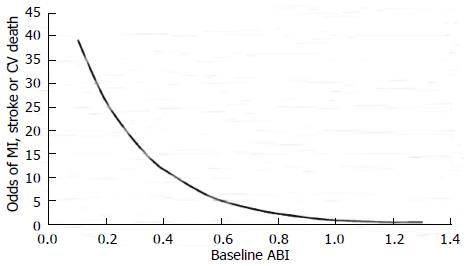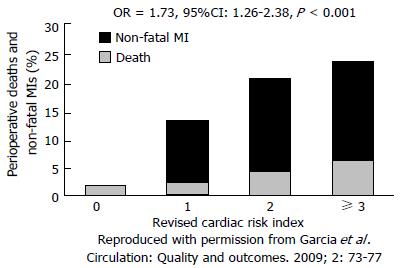Copyright
©2014 Baishideng Publishing Group Inc.
World J Cardiol. Oct 26, 2014; 6(10): 1100-1107
Published online Oct 26, 2014. doi: 10.4330/wjc.v6.i10.1100
Published online Oct 26, 2014. doi: 10.4330/wjc.v6.i10.1100
Figure 1 Data from the Reduction of Atherothrombosis for Continued Health registry.
Approximately 50% of patients with peripheral arterial disease (PAD) and polyvascular disease have concomitant coronary artery disease. Reproduced with permission from society for vascular surgery.
Figure 2 Odds of a major cardiovascular event according to baseline ankle-brachial index in patients with diabetes mellitus.
Reproduced with permission from Mehler et al[16]. MI: Myocardial infarction; CV: Cardiovascular, ABI: Ankle-brachial index.
Figure 3 Outcomes at 30 d following vascular surgery according to number of risks as enumerated in the revised cardiac risk index.
MI: Myocardial infarction.
Figure 4 Primary outcome of the coronary artery revascularization prophylaxis trial: Overall survival at 2.
7 yr was no different between groups (22 % vs 23%).
Figure 5 The vascular events in Noncardiac Surgery Patients Cohort Evaluation Study.
Peak troponin T values (TnT) of 0.02 ng/mL were associated with increased (4%) risk of death at 30 d relative to TnT levels < 0.01. Reproduced with permission from Devereaux et al[28].
- Citation: Garcia S, McFalls EO. Perioperative clinical variables and long-term survival following vascular surgery. World J Cardiol 2014; 6(10): 1100-1107
- URL: https://www.wjgnet.com/1949-8462/full/v6/i10/1100.htm
- DOI: https://dx.doi.org/10.4330/wjc.v6.i10.1100













